Pro-Inflammatory Cytokines Expressed During the Initial Phases of Osseointegration: A Systematic Review
Abstract
1. Introduction
2. Materials and Methods
2.1. Focus Question
2.2. Search Strategy
2.3. Selection Criteria
2.4. Data Synthesis
2.5. Quality Assessment
3. Results
3.1. Study Selection
Assessment and Risk of Bias
3.2. Study Characteristics
3.3. Individual Biomarker Outcomes
3.4. Interleukin 1-β (IL-1β)
3.5. TNF-α
3.6. IL-6
3.7. IL-10
3.8. IL-8
3.9. IL-12
3.10. IL-17A, IL-17E
3.11. RANKL/sRANKL and OPG
3.12. Chemokines
3.13. Other Biomarkers
4. Discussion
5. Conclusions
Author Contributions
Funding
Institutional Review Board Statement
Informed Consent Statement
Data Availability Statement
Conflicts of Interest
Appendix A. Biomarkers and Their Respective Timepoints Across Studies
| Biomarker | Baseline—1 Day | 2 Days | 1 Week/ 7 Days | 2 Weeks/15 Days | 3 Weeks | 4 Weeks/28–30 Days/1 Month | 6 Weeks | 8 Weeks/2 Months/60 Days | 90 Days/12 Weeks/3 Months |
| TNF-alpha | [42] | [13,35] | [8,16,23,29,35,42,43] | [8,13,21,23,29,32,37,42,43] | [29] | [8,13,21,23,26,30,32,34,35,37,38,42,43] | [29,37] | [8,23,29,32,34,38,42,43] | [8,13,16,21,23,24,29,30,32,34,35,37,42,43] |
| IL-1B | [13,35] | [8,11,16,23,25,29,35,43] | [8,13,28,29,32,37,43] | [29] | [8,13,26,30,31,32,34,35,36,37,43] | [29,37] | [8,29,32,34,36,43] | [8,13,16,24,29,30,31,32,34,35,37,43] | |
| IL-6 | [42] | [8,16,23,25,29,42] | [8,23,29,32,42] | [29] | [8,23,32,34,38,42] | [29] | [8,23,29,32,34,38,42] | [8,16,23,29,32,34,42] | |
| IL-8 | [42] | [16,25,29,42] | [11,29,32,42] | [29] | [32,38,42] | [29] | [29,32,42] | [16,29,32,38,42] | |
| IL-10 | [8,16,23,29] | [8,23,29,32] | [29] | [8,23,32,34,38] | [29] | [8,23,29,32,34] | [8,16,23,29,32,34,38] | ||
| IL-17A | [15] | [16] | [32] | [15,32] | [32] | [16,32] | |||
| IL-17E | [15] | [15] | |||||||
| IL-7 | [29] | [29,32] | [29] | [32] | [29] | [29,32] | [29,32] | ||
| IL-12/IL-12p70/IL-12A | [16,29] | [29,32] | [29] | [32,38] | [29] | [29,32,38] | [16,29,32] | ||
| IL-4 | [16] | [32] | [32,38] | [32,38] | [16,32] | ||||
| IL-1α | [16] | [38] | [38] | [16] | |||||
| IL-1Ra | [29] | [29,32] | [29] | [32] | [29] | [29,32] | [29,32] | ||
| CCL3 | [16,25,29] | [29,32] | [29] | [32] | [29] | [29,32] | [16,29,32] | ||
| CCL-11 | [29] | [29] | [29] | [29] | [29] | [29] | |||
| CCL-2 | [32] | [32] | [32] | [32] | |||||
| CCL-4 | [29] | [29,32] | [29] | [32] | [29] | [29,32] | [29,32] | ||
| PGE2 | [31,36] | [36] | [22,31] | ||||||
| CCL-5 | [32] | [32] | [32] | [32] | |||||
| RANKL/sRANKL | [16,33,39,44] | [21,33,40,44] | [21,27,33,40] | [33,44] | [33,40] | [16,21,27,33,40,44] | |||
| OPG | [16,33,39] | [21,33,40] | [21,33,40] | [33] | [33,40] | [16,21,27,33,40] | |||
| RANKL:OPG | |||||||||
| INF-γ | [16] | [32] | [32,38] | [32,38] | [16,32] | ||||
| IL-2 | [16] | [32] | [32] | [32] | [16,32] | ||||
| GCSF, GMCSF INF-α, IL-2r, IL-13, IL-5, IL-15, CXCL-9, CXCL-10 | [32] | [32] | [32] | [32] | |||||
| CRP | [16] | [16] | |||||||
| Biomarker | 1 Day | 2 Days | 1 Week/ 7 Days | 2 Weeks/15 days | 3 Weeks | 4 weeks/30 Days/1 Month | 6 Weeks | 8 Weeks/2 Months/60 Days | 90 Days/12 Weeks/3 Months |
References
- Trindade, R.; Albrektsson, T.; Tengvall, P.; Wennerberg, A. Foreign Body Reaction to Biomaterials: On Mechanisms for Buildup and Breakdown of Osseointegration. Clin. Implant. Dent. Relat. Res. 2016, 18, 192–203. [Google Scholar] [CrossRef] [PubMed]
- Chen, Z.; Wu, C.; Gu, W.; Klein, T.; Crawford, R.; Xiao, Y. Osteogenic differentiation of bone marrow MSCs by beta-tricalcium phosphate stimulating macrophages via BMP2 signalling pathway. Biomaterials 2014, 35, 1507–1518. [Google Scholar] [CrossRef] [PubMed]
- Emam, S.M.; Moussa, N. Signaling pathways of dental implants’ osseointegration: A narrative review on two of the most relevant; NF-kappaB and Wnt pathways. BDJ Open 2024, 10, 29. [Google Scholar] [CrossRef] [PubMed]
- Nevins, M.; Chen, C.-Y.; Khang, W.; Kim, D.M. Clinical and histological efficacy of a new implant surface in achieving early and stable osseointegration: An in vivo study. Int. J. Oral Implantol. 2024, 17, 297–306. [Google Scholar]
- Bai, L.; Liu, Y.; Du, Z.; Weng, Z.; Yao, W.; Zhang, X.; Huang, X.; Yao, X.; Crawford, R.; Hang, R.; et al. Differential effect of hydroxyapatite nano-particle versus nano-rod decorated titanium micro-surface on osseointegration. Acta Biomater. 2018, 76, 344–358. [Google Scholar] [CrossRef]
- Hankenson, K.D.; Dishowitz, M.; Gray, C.; Schenker, M. Angiogenesis in bone regeneration. Injury 2011, 42, 556–561. [Google Scholar] [CrossRef]
- Zhou, A.; Yu, H.; Liu, J.; Zheng, J.; Jia, Y.; Wu, B.; Xiang, L. Role of Hippo-YAP Signaling in Osseointegration by Regulating Osteogenesis, Angiogenesis, and Osteoimmunology. Front. Cell Dev. Biol. 2020, 8, 780. [Google Scholar] [CrossRef]
- Bielemann, A.M.; Marcello-Machado, R.M.; Leite, F.R.M.; Martinho, F.C.; Chagas-Júnior, O.L.; Cury, A.A.D.B.; Faot, F. Comparison between inflammation-related markers in peri-implant crevicular fluid and clinical parameters during osseointegration in edentulous jaws. Clin. Oral Investig. 2018, 22, 531–543. [Google Scholar] [CrossRef]
- Albrektsson, T.; Johansson, C. Osteoinduction, osteoconduction and osseointegration. Eur. Spine J. 2001, 10 (Suppl. 2), S96–S101. [Google Scholar]
- Chang, P.C.; Lang, N.P.; Giannobile, W.V. Evaluation of functional dynamics during osseointegration and regeneration associated with oral implants. Clin. Oral Implants Res. 2010, 21, 1–12. [Google Scholar] [CrossRef]
- Khoury, S.B.; Thomas, L.; Walters, J.D.; Sheridan, J.F.; Leblebicioglu, B. Early wound healing following one-stage dental implant placement with and without antibiotic prophylaxis: A pilot study. J. Periodontol. 2008, 79, 1904–1912. [Google Scholar] [CrossRef] [PubMed]
- Gruber, R.; Nadir, J.; Haas, R. Neutrophil elastase activity and concentrations of interleukin 1-beta in crevicular fluid after immediate replacement and immediate loading of implants. Br. J. Oral Maxillofac. Surg. 2010, 48, 228–231. [Google Scholar] [CrossRef] [PubMed]
- Slotte, C.; Lennerås, M.; Göthberg, C.; Suska, F.; Zoric, N.; Thomsen, P.; Nannmark, U. Gene expression of inflammation and bone healing in peri-implant crevicular fluid after placement and loading of dental implants. A kinetic clinical pilot study using quantitative real-time PCR. Clin. Implant. Dent. Relat. Res. 2012, 14, 723–736. [Google Scholar] [CrossRef] [PubMed]
- Meriç, P.; Buduneli, N.; Kanmaz, B.; Gürlek, Ö.; Çömlekoğlu, E.; Calvert, G.; Lappin, D.F.; Nile, C. Cholinergic signalling mechanisms and early implant healing phases in healthy versus generalized aggressive periodontitis patients: A prospective, case–control study. J. Clin. Periodontol. 2019, 46, 1155–1163. [Google Scholar] [CrossRef]
- Kapasa, E.R.; Giannoudis, P.V.; Jia, X.; Hatton, P.V.; Yang, X.B. The Effect of RANKL/OPG Balance on Reducing Implant Complications. J. Funct. Biomater. 2017, 8, 42. [Google Scholar] [CrossRef]
- Wehner, C.; Fürst, G.; Vaskovich, T.; Andrukhov, O.; Vasak, C.; Moritz, A.; Rausch-Fan, X. Effects of customized CAD/CAM abutments on cytokine levels in peri-implant crevicular fluid during early implant healing: A pilot study. Clin. Oral Investig. 2023, 27, 2621–2628. [Google Scholar] [CrossRef]
- Miron, R.J.; Bohner, M.; Zhang, Y.; Bosshardt, D.D. Osteoinduction and osteoimmunology: Emerging concepts. Periodontology 2000, 94, 9–26. [Google Scholar] [CrossRef]
- Terheyden, H.; Lang, N.P.; Bierbaum, S.; Stadlinger, B. Osseointegration—Communication of cells. Clin. Oral Implants Res. 2012, 23, 1127–1135. [Google Scholar] [CrossRef]
- Downs, S.H.; Black, N. The feasibility of creating a checklist for the assessment of the methodological quality both of randomised and non-randomised studies of health care interventions. J. Epidemiol. Community Health 1998, 52, 377–384. [Google Scholar] [CrossRef]
- Chudyk, A.M.; Jutai, J.W.; Petrella, R.J.; Speechley, M. Systematic review of hip fracture rehabilitation practices in the elderly. Arch. Phys. Med. Rehabil. 2009, 90, 246–262. [Google Scholar] [CrossRef]
- Atilgan, M.; Arpag, O.F.; Özcan, O.; Kaçmaz, F. Biochemical Evaluation of the Effects of Concentrated Growth Factor Liquid on Osseointegration: A Split-Mouth Design Study. Int. J. Oral Maxillofac. Implant. 2023, 38, 1182–1190. [Google Scholar] [CrossRef] [PubMed]
- Basegmez, C.; Yalcin, S.; Yalcin, F.; Ersanli, S.; Mijiritsky, E. Evaluation of periimplant crevicular fluid prostaglandin e2 and matrix metalloproteinase-8 levels from health to periimplant disease status: A prospective study. Implant. Dent. 2012, 21, 306–310. [Google Scholar] [CrossRef] [PubMed]
- Bielemann, A.M.; Marcello-Machado, R.M.; Schuster, A.J.; Júnior, O.L.C.; Cury, A.A.D.B.; Faot, F. Healing differences in narrow diameter implants submitted to immediate and conventional loading in mandibular overdentures: A randomized clinical trial. J. Periodontal. Res. 2019, 54, 241–250. [Google Scholar] [CrossRef] [PubMed]
- Boynuegri, A.D.; Yalım, M.; Nemli, S.K.; Ergüder, B.I.; Gökalp, P. Effect of different localizations of microgap on clinical parameters and inflammatory cytokines in peri-implant crevicular fluid: A prospective comparative study. Clin. Oral Investig. 2012, 16, 353–361. [Google Scholar] [CrossRef]
- De Wilde, E.A.; Jimbo, R.; Wennerberg, A.; Naito, Y.; Coucke, P.; Bryington, M.S.; Vandeweghe, S.; De Bruyn, H. The soft tissue immunologic response to hydroxyapatite-coated transmucosal implant surfaces: A study in humans. Clin. Implant. Dent. Relat. Res. 2015, 17 (Suppl. 1), e65–e74. [Google Scholar] [CrossRef]
- Dogan, S.B.; Kurtiş, B.; Tşter, G.; Serdar, M.; Watanabe, K.; Karakış, S. Evaluation of Clinical Parameters and Levels of Proinflammatory Cytokines in the Crevicular Fluid Around Dental Implants in Patients with Type 2 Diabetes Mellitus. Int. J. Oral Maxillofac. Implants 2015, 30, 1119–1127. [Google Scholar] [CrossRef]
- Dolanmaz, D.; Saglam, M.; Inan, O.; Dundar, N.; Alniacık, G.; Trak, B.G.; Kocak, E.; Hakki, S.S. Monitoring bone morphogenetic protein-2 and -7, soluble receptor activator of nuclear factor-κB ligand and osteoprotegerin levels in the peri-implant sulcular fluid during the osseointegration of hydrophilic-modified sandblasted acid-etched and sandblasted acid-etched surface dental implants. J. Periodontal. Res. 2015, 50, 62–73. [Google Scholar]
- Elsyad, M.A.; Mahanna, F.F.; Elshahat, M.A.; Elshoukouki, A.H. Locators versus magnetic attachment effect on peri-implant tissue health of immediate loaded two implants retaining a mandibular overdenture: A 1-year randomised trial. J. Oral Rehabil. 2016, 43, 297–305. [Google Scholar] [CrossRef]
- Emecen-Huja, P.; Eubank, T.D.; Shapiro, V.; Yildiz, V.; Tatakis, D.N.; Leblebicioglu, B. Peri-implant versus periodontal wound healing. J. Clin. Periodontol. 2013, 40, 816–824. [Google Scholar] [CrossRef]
- Faot, F.; Bielemann, A.M.; Schuster, A.J.; Marcello-Machado, R.M.; Cury, A.A.D.B.; Nascimento, G.G.; Chagas-Junior, O.L. Influence of insertion torque on clinical and biological outcomes before and after loading of mandibular implant-retained overdentures in atrophic edentulous mandibles. BioMed Res. Int. 2019, 2019, 8132520. [Google Scholar] [CrossRef]
- Gokmenoglu, C.; Ozmeric, N.; Erguder, I.; Elgun, S. The effect of light-emitting diode photobiomodulation on implant stability and biochemical markers in peri-implant crevicular fluid. Photomed. Laser Surg. 2014, 32, 138–145. [Google Scholar] [CrossRef] [PubMed]
- Gürkan, A.; Tekdal, G.P.; Bostancı, N.; Belibasakis, G.N. Cytokine, chemokine, and growth factor levels in peri-implant sulcus during wound healing and osseointegration after piezosurgical versus conventional implant site preparation: Randomized, controlled, split-mouth trial. J. Periodontol. 2019, 90, 616–626. [Google Scholar] [CrossRef] [PubMed]
- Ma, P.; Wu, H. Correlation analysis between bone metabolism factors and the stability of dental implant in the postoperative recovery of dental implanted patients. Int. J. Clin. Exp. Med. 2018, 11, 3924–3931. [Google Scholar]
- Marcello-Machado, R.M.; Faot, F.; Schuster, A.J.; Bielemann, A.M.; Nascimento, G.G.; Cury, A.A.D.B. Mapping of inflammatory biomarkers in the peri-implant crevicular fluid before and after the occlusal loading of narrow diameter implants. Clin. Oral Investig. 2020, 24, 1311–1320. [Google Scholar] [CrossRef]
- Mayuri, S.; Irfan, A.K.; Raj, R.; Sen, A.; Malik, R.; Bandgar, S.; Rangari, P. Success of dental implant influenced by abutment types and loading protocol. J. Pharm. Bioallied Sci. 2022, 14, S1019–S1022. [Google Scholar] [CrossRef]
- Memarian, J.; Ketabi, M.; Amini, S. The effect of low-level laser 810 nm and light-emitting diode photobiomodulation (626 nm) on the stability of the implant and inflammatory markers interleukin-1 beta and prostaglandin E2, around implants. Dent. Res. J. 2018, 15, 283–288. [Google Scholar]
- Nayak, B.P.; Dolkart, O.; Satwalekar, P.; Kumar, Y.P.; Chandrasekar, A.; Fromovich, O.; Yakobson, E.; Barak, S.; Dayube, U.; Shibli, J.A. Effect of the Pulsed Electromagnetic Field (PEMF) on Dental Implants Stability: A Randomized Controlled Clinical Trial. Materials 2020, 13, 1667. [Google Scholar] [CrossRef]
- Nogueira-Filho, G.; Pesun, I.; Isaak-Ploegman, C.; Wijegunasinghe, M.; Wierzbicki, T.; McCulloch, C.A. Longitudinal comparison of cytokines in peri-implant fluid and gingival crevicular fluid in healthy mouths. J. Periodontol. 2014, 85, 1582–1588. [Google Scholar] [CrossRef]
- Onuma, T.; Aquiar, K.; Duarte, P.; Feres, M.; Giro, G.; Coelho, P.; Cassoni, A.; Shibli, J. Levels of osteoclastogenesis-related factors in the peri-implant crevicular fluid and clinical parameters of immediately loaded implants in patients with osteopenia: A short-term report. Int. J. Oral Maxillofac. Implants 2015, 30, 1431–1436. [Google Scholar] [CrossRef]
- Peker Tekdal, G.; Bostanci, N.; Belibasakis, G.N.; Gürkan, A. The effect of piezoelectric surgery implant osteotomy on radiological and molecular parameters of peri-implant crestal bone loss: A randomized, controlled, split-mouth trial. Clin. Oral Implants Res. 2016, 27, 535–544. [Google Scholar] [CrossRef]
- Sayardoust, S.; Omar, O.; Norderyd, O.; Thomsen, P. Clinical, radiological, and gene expression analyses in smokers and non-smokers, Part 2: RCT on the late healing phase of osseointegration. Clin. Implant. Dent. Relat. Res. 2017, 19, 901–915. [Google Scholar] [CrossRef] [PubMed]
- Sayardoust, S.; Omar, O.; Thomsen, P. Gene expression in peri-implant crevicular fluid of smokers and nonsmokers. 1. The early phase of osseointegration. Clin. Implant. Dent. Relat. Res. 2017, 19, 681–693. [Google Scholar] [CrossRef] [PubMed]
- Schuster, A.J.; Possebon, A.P.d.R.; Bielemann, A.M.; Chagas-Júnior, O.L.; Faot, F. Effect of mandibular residual ridge regularization on peri-implant wound healing when narrow diameter implants are used as overdenture retainers. J. Prosthet. Dent. 2022, 128, 648–655. [Google Scholar] [CrossRef] [PubMed]
- Tsoukaki, M.; Kalpidis, C.D.R.; Sakellari, D.; Tsalikis, L.; Mikrogiorgis, G.; Konstantinidis, A. Clinical, radiographic, microbiological, and immunological outcomes of flapped vs. flapless dental implants: A prospective randomized controlled clinical trial. Clin. Oral Implants Res. 2013, 24, 969–976. [Google Scholar] [CrossRef]
- Aboyoussef, H.; Carter, C.; Jandinski, J.J.; Panagakos, F.S. Detection of prostaglandin E2 and matrix metalloproteinases in implant crevicular fluid. Int. J. Oral Maxillofac. Implants 1998, 13, 689–696. [Google Scholar]
- Tomasi, C.; Tessarolo, F.; Caola, I.; Piccoli, F.; Wennström, J.L.; Nollo, G.; Berglundh, T. Early healing of peri-implant mucosa in man. J. Clin. Periodontol. 2016, 43, 816–824. [Google Scholar] [CrossRef]
- Tomasi, C.; Tessarolo, F.; Caola, I.; Wennström, J.; Nollo, G.; Berglundh, T. Morphogenesis of peri-implant mucosa revisited: An experimental study in humans. Clin. Oral Implants Res. 2014, 25, 997–1003. [Google Scholar] [CrossRef]
- Lang, N.P.; Salvi, G.E.; Huynh-Ba, G.; Ivanovski, S.; Donos, N.; Bosshardt, D.D. Early osseointegration to hydrophilic and hydrophobic implant surfaces in humans. Clin. Oral Implants Res. 2011, 22, 349–356. [Google Scholar] [CrossRef]
- Galindo-Moreno, P.; Catena, A.; Pérez-Sayáns, M.; Fernández-Barbero, J.E.; O’Valle, F.; Padial-Molina, M. Early marginal bone loss around dental implants to define success in implant dentistry: A retrospective study. Clin. Implant. Dent. Relat. Res. 2022, 24, 630–642. [Google Scholar] [CrossRef]
- Sgolastra, F.; Petrucci, A.; Severino, M.; Gatto, R.; Monaco, A. Periodontitis, implant loss and peri-implantitis. A meta-analysis. Clin. Oral Implants Res. 2015, 26, e8–e16. [Google Scholar] [CrossRef]
- Swierkot, K.; Lottholz, P.; Flores-de-Jacoby, L.; Mengel, R. Mucositis, peri-implantitis, implant success, and survival of implants in patients with treated generalized aggressive periodontitis: 3- to 16-year results of a prospective long-term cohort study. J. Periodontol. 2012, 83, 1213–1225. [Google Scholar] [CrossRef]
- Dursun, E.; Tozum, T.F. Peri-Implant Crevicular Fluid Analysis, Enzymes and Biomarkers: A Systemetic Review. J. Oral Maxillofac. Res. 2016, 7, e9. [Google Scholar] [CrossRef]
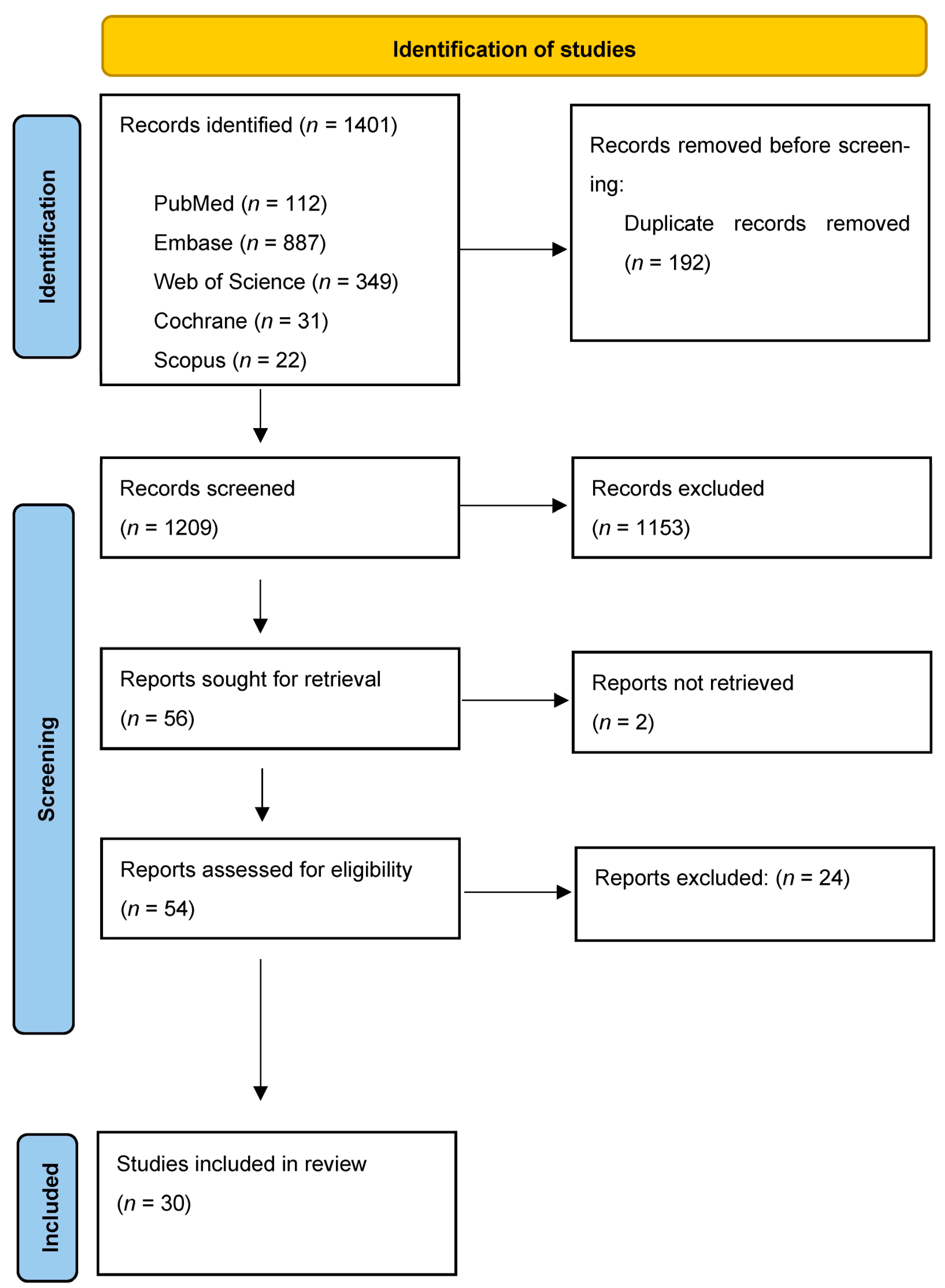
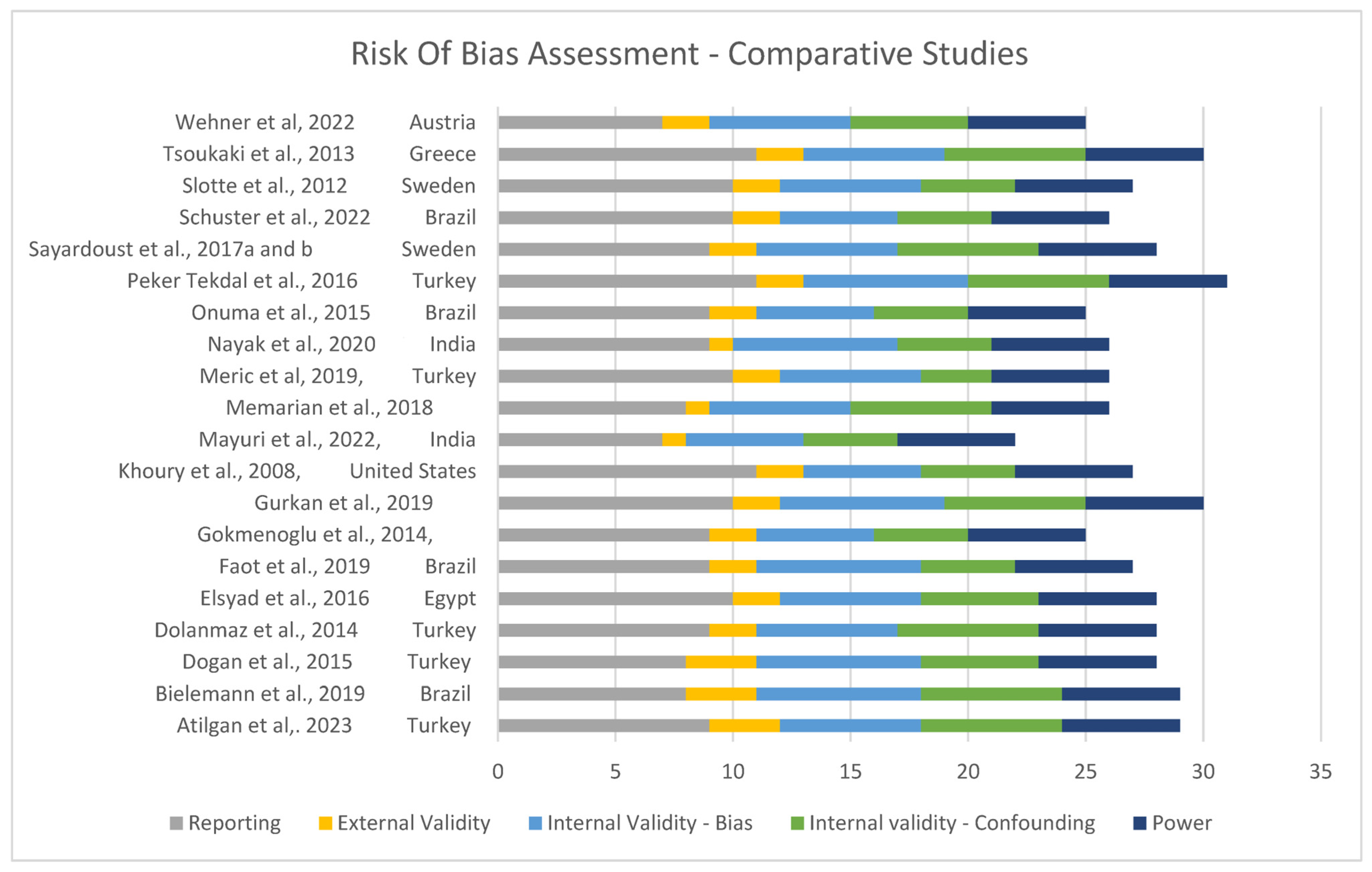
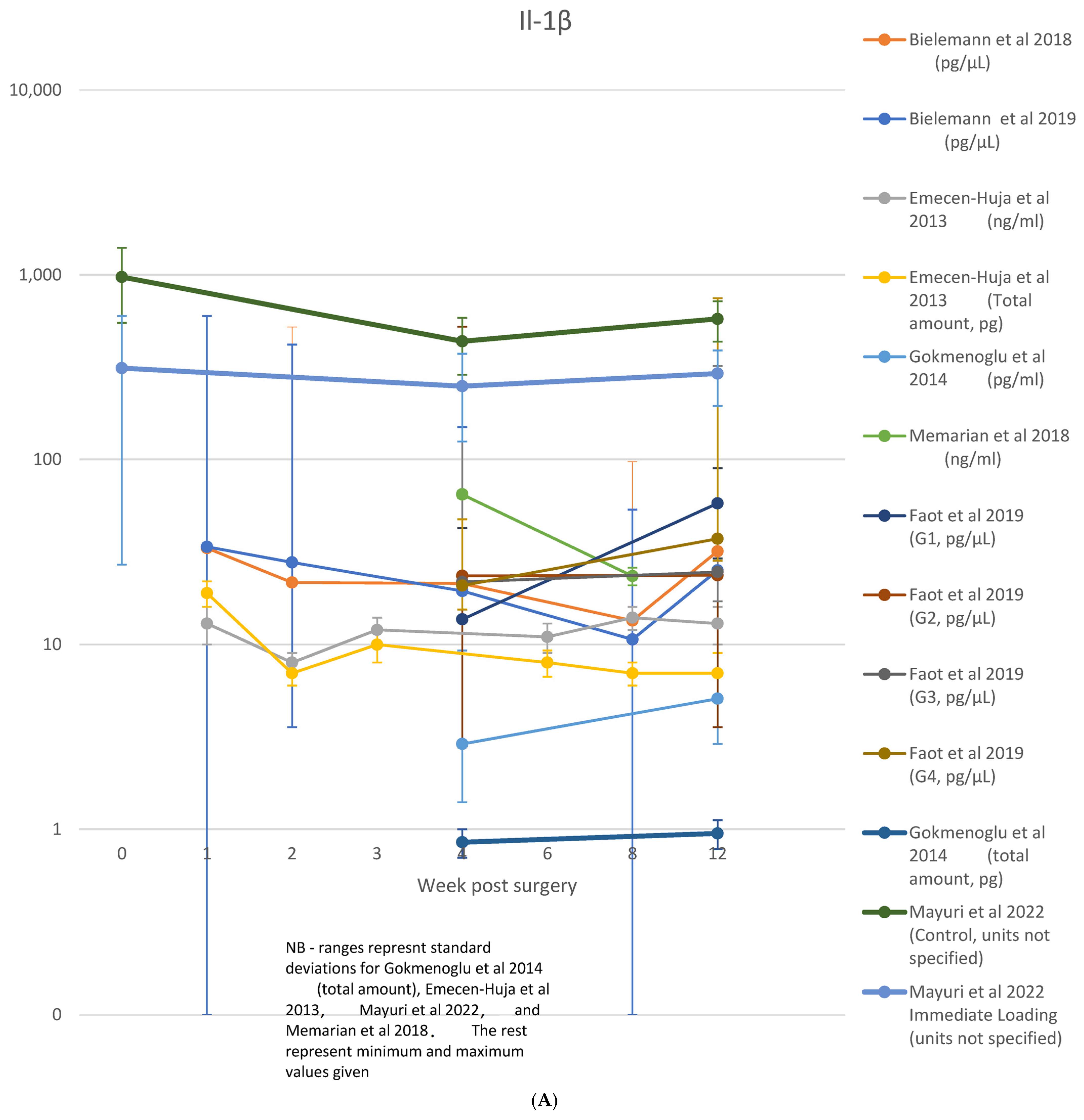
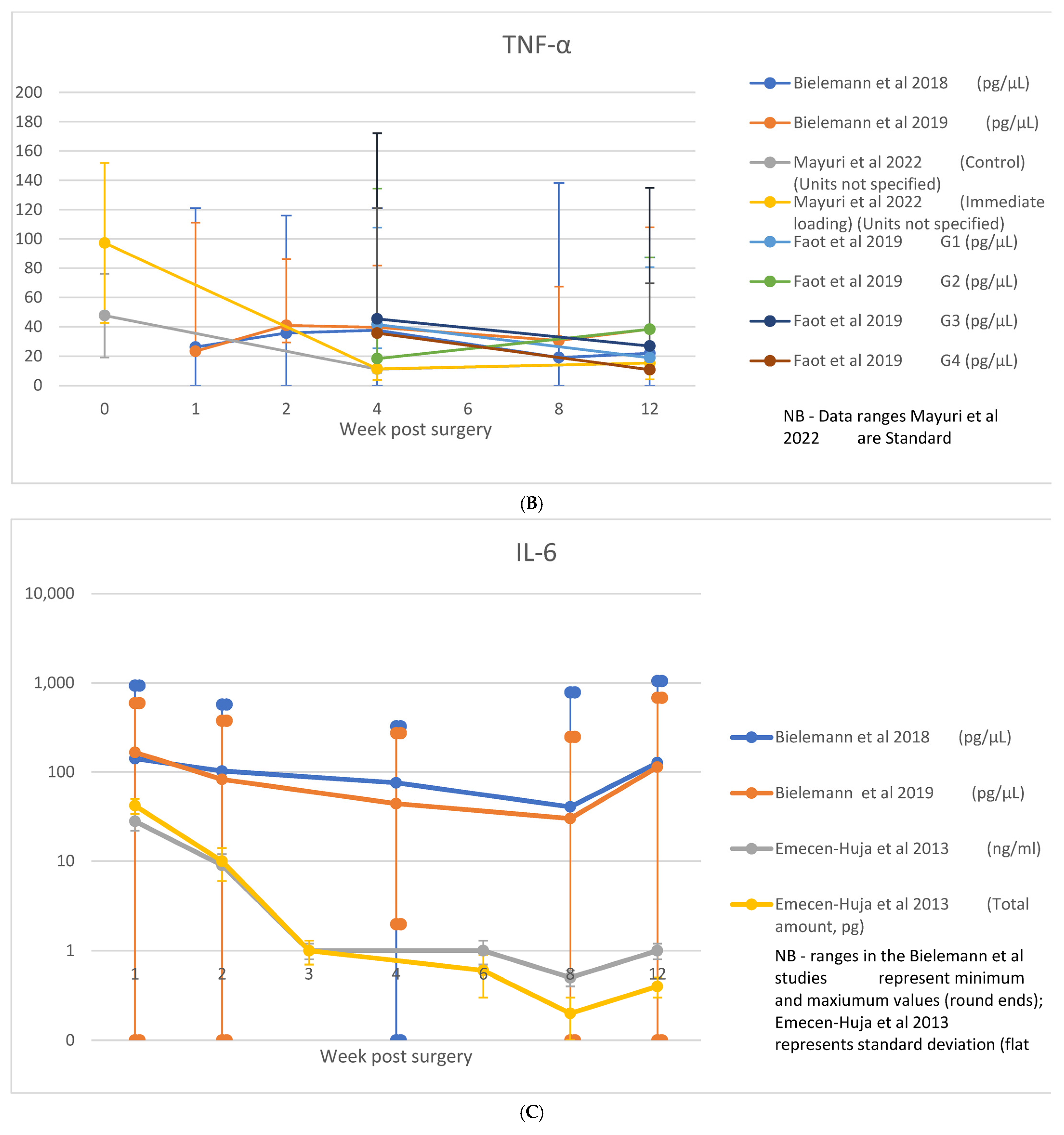
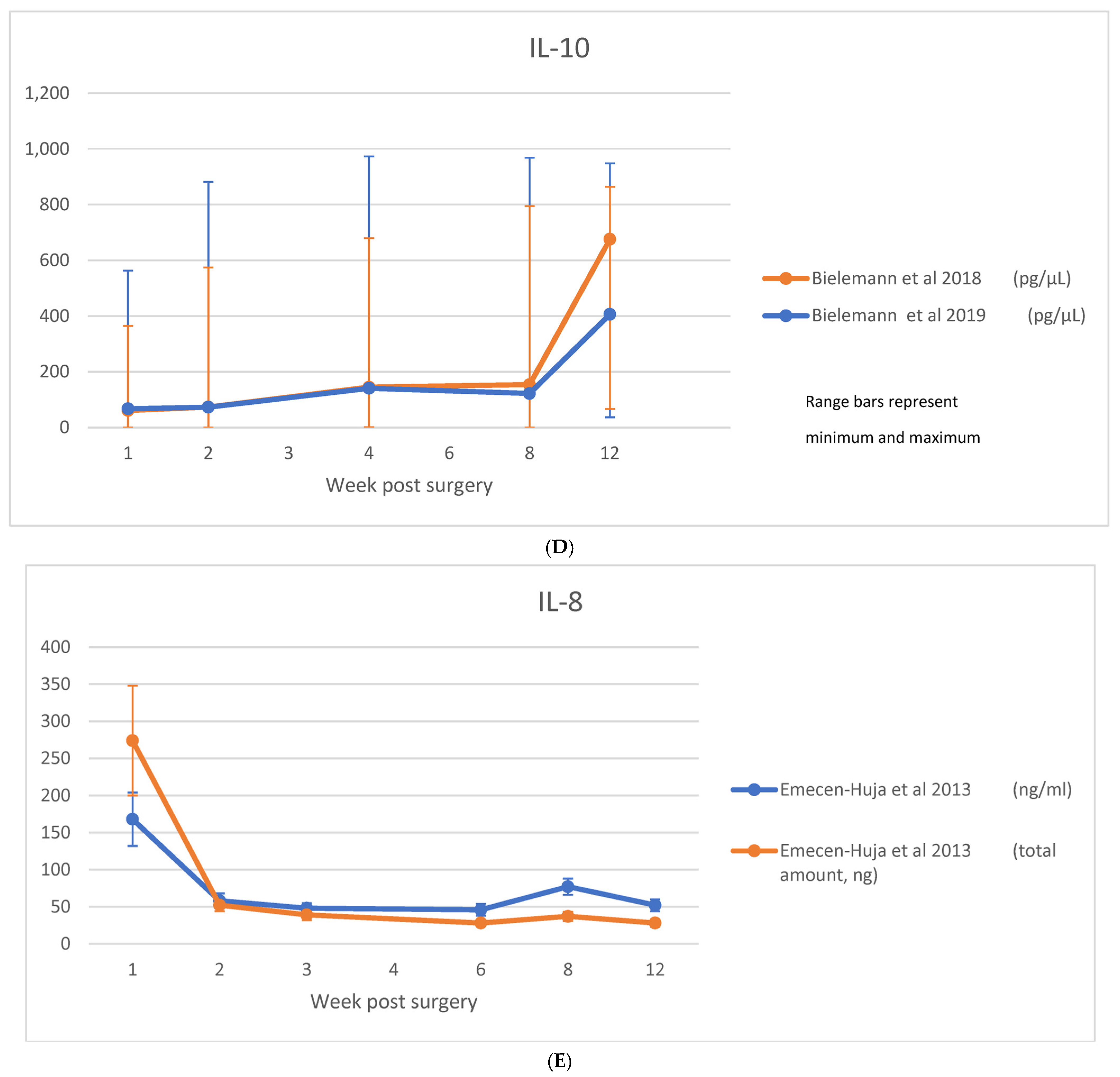
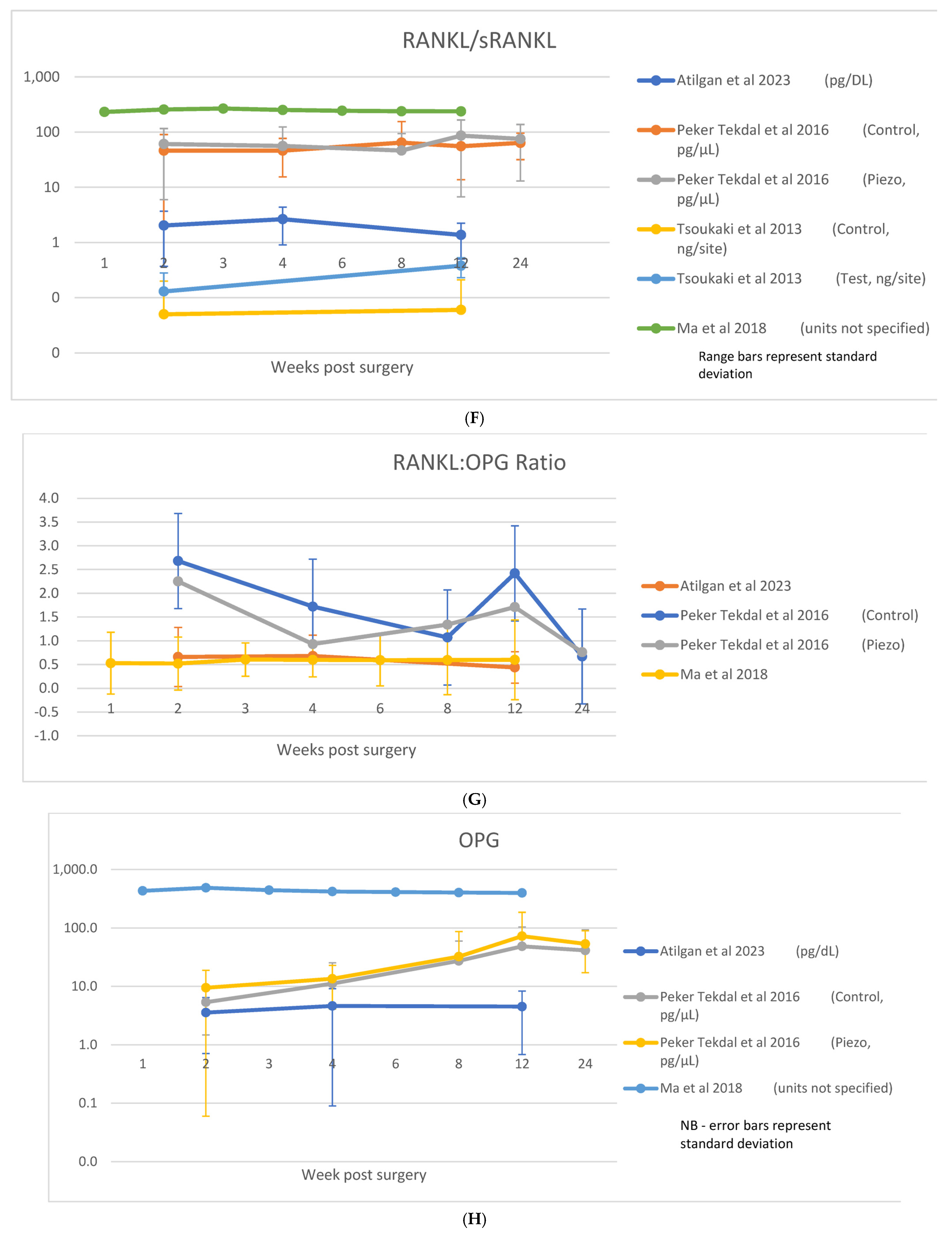
| Author, Year, Country, Study Design | N | Implants (n), Brand | Follow-Up | Outcome Variables | Treatment Variables | Bone Site/Prosthetic Treatment | Abutment or Restoration | Biomarkers | Antibiotics | Methodology for Analysis |
|---|---|---|---|---|---|---|---|---|---|---|
| Atilgan et al., 2023 [21], Turkey (RCT) | 20 | 40, T6 NucleOSS | 2, 4, 12 weeks | RFA, MBL, PI, GI, PD, GBI | Concentrated Growth Factors | Mandibular Bilateral Edentulous Spaces | Abutment Only | TNF-α, RANKL, OPG | No | |
| Basegmez et al., 2012 [22], Turkey (Long) | 28 | 72, Branemark/Nobel Biocare | 3, 6, 12, 18 months | PI, GI, PD | Totally Edentulous (Jaw Not Specified) | 3 Months, Not Specified | PGE2 | Not Specified | Assay Designs, Inc., Ann Arbor, MI, USA | |
| Bielemann et al., 2018 [8], Brazil (Long) | 30 | 60, Neodent Brazil | 1, 2, 4, 8, 12 weeks | PI Calculus, PD, BOP, GI | Mandibular Overdenture | 3 Months | IL-1B, IL-6, IL-10, TNF-a | Amoxil 500 mg TID 7 Days | ELISA (Duoset Kit, R&D, Minneapolis, MN, USA) | |
| Bielemann et al., 2019 [23], Brazil (RCT) | 20 | 40, Neodent Brazil | 1, 2, 4, 8, 12 weeks | ISQ, PI, GI, Calculus, PD, BOP | Immediate vs. Delayed Loading | Mandibular Overdenture | Immediate (Test), Delayed (Control) | IL-1B, IL-6, IL-10, TNF-a | Amoxil 500 mg TID 7 Days | ELISA (Duoset Kit, R&D, Minneapolis, MN, USA) |
| Boynuegri et al., 2012 [24], Turkey (RCT) | 10 | 40, Straumann, Switzerland | 3, 6, 12 months | PD, GI, BOP, PI | Location of Abutment Interface | Mandibular Overdenture (Dolder Bar) | 3 Months (Dolder Bar) | IL-1B, TNF-a | No | ELISA (Biosource, Minneapolis, MN, USA) |
| De Wilde et al., 2015 [25], Belgium (RCT) | 12 | 13 | 1 week | - | Hydroxyapatite vs. Commercially Pure Ti | Partially Edentulous | NA | IL-6, CCL-3, IL-8, IL-1B | No | mRNA (miRNeasy Mini Kit, Qiagen, Venlo, The Netherlands) |
| Dogan et al., 2015 [26], Turkey (Comparative Obs.) | 20 | 39, Straumann SLActive, Switzerland | Baseline, 1, 4, 7 months | PI, GI, PD, BOP, CAL, KGW, ISQ, MBL | Diabetic vs. Non-Diabetic | Partially Edentulous | Restored at 4 Months | IL-1B, TNF-a | Amoxil 1000 mg + Clavulanic Acid BID 5 days Prophylactic | ELISA Conc. and Total amount (Orgenium Laboratories Oy/Ani Biotech Oy, Minneapolis, MN, USA) |
| Dolanmaz et al. 2015 [27], Turkey (RCT) | 47 | 47, Straumann AND NucleOSS | 1, 3 months | PI, GI, PD, RFA | Modification of Implant Surface (SLActive) | Mandible Sites | Abutment Only | sRANKL, OPG | Amoxil 500 mg TID 7 Days | ELISA (Biovendor, Minneapolis, MN, USA) |
| Elsyad et al., 2016 [28], Egypt (RCT) | 32 | 64, Dentarum, Germany | 2 weeks, 6 months | Plaque, Bleeding, PD, RFA, HBL, VBL | Locators vs. Magnetic Attachment | Mandibular Overdenture | Immediate Restoration | IL-1B | Amoxil 2 g (Prophylactic) | Sandwich ELISA (FIRICH ENTERPRISES CO, LTD, New Taipei City, Taiwan) |
| Emecen-Huja et al., 2013 [29], United States (Comparative Obs.) | 40 | 40, Astra; Straumann; Zimmer | 1, 2, 3, 6, 8, 12 weeks | PI, GI | Comparison to Adjacent Tooth and Nonadjacent Teeth | Mandibular Single Tooth | Abutment Only | IL-1b, IL-1ra, IL6, IL-7, IL-8, IL-10, IL-12, Eotaxin, MCP-1, TNF-a, MIP-1b (CCL-4) | No | Multiplex Bead Assay (Bioplex, Bio-Rad Laboratories, Berkeley, CA, USA) |
| Faot et al., 2019 [30], Brazil (Comparative Int.) | 31 | 62, Neodent, Brazil | 4, 12 weeks | GI, PIH, PI, Calculus, PD, BOP, RFA | Insertion Torque | Mandibular Overdenture | 3 Months | IL-1B, TNF-a | Amoxil 500 mg TID 7 Days | Not Specified |
| Gokmenoglu et al., 2014 [31], Turkey (RCT) | 15 | 22, Dentsply, Germany | 4, 12 weeks | PI, GI, PG, BOP, RFA | Photobiomodulation | Single Tooth; Type 2 or 3 bone | Abutment Only | IL-1B, PGE2 | No | ELISA (Dbendermed Systems, Vienna, Austria) Conc. and Total Amount |
| Gruber et al., 2010 [12], Austria (Long) | 11 | 11, Nobelreplace Nobel Biocare, Sweden | 1–10 days, >10 days | - | Immediate Placement and Loading | Immediate Restoration | IL-1B | No | ELISA (R&D Systems, Minneapolis, MN, USA) | |
| Gurkan et al., 2019 [32], Turkey (RCT) | 14 | 38, Biodenta Switzerland | 2, 4, 8, 12, 24 weeks | Insertion torque, early healing index, PI, mGI, mPI, MBL | Piezosurgery vs. Conventional | Bilateral Posterior Maxilla | Abutment Only | GCSF, GM-CSF, INFa, INFy, IL-1B, IL-1RA, IL-2, IL-2R, IL-4, IL-5, IL-6, IL-7, IL-8, IL-10, IL-12, IL-13, IL-15, IL17, TNF-a, MIP-1a (CCL3), MIP-1b (CCL4), MCP-1 (CCL2), RANTES (CCL5), MIG (CXCL-9), IP-10, (CXCL10), Eotaxin (CCL-11) | Amoxil 2 g (Prophylactic) | Multiplex Bead Assay (Novex/xPONENT, ThermoFisher Scientific, Waltham, MA, USA) |
| Khoury et al., 2008 [11], United States (RCT) | 20 | 20, Astra, Sweden; Zimmer, USA | 1 week | PI, GI | Antibiotic (Prophylactic and Post-operative) | Bound Edentulous Site | Abutment Only | IL-1B, IL-8 | Amoxil 2 g (Prophylactic), 500 mg Amoxil TID 7 Days (Test); None for control | ELISA (R&D Systems, Minneapolis, MN, USA) |
| Ma and Wu, 2018 [33], China (Retro) | 78 | 78, Straumann, Switzerland | 1, 2, 4, 6, 8, 12 weeks | Survival; complications; RFA, mPI, mSBI | Single Tooth Maxilla or Mandible | Abutment Only | RANKL, OPG, | No | ||
| Marcello-Machado et al., 2020 [34], Brazil (Long) | 16 | 32, Neodent Brazil | 4, 8, 12, 24, 48 weeks | Bone density, PI, GI, calculus, PD, BOP, RFA, MBL | Mandibular Overdenture | Restored at 12 Weeks | TNF-a, IL-1B, IL-6, IL-10 | No | ELISA (Duoset Kit, R&D, Minneapolis, MN, USA) | |
| Mayuri et al., 2022 [35], India (RCT) | 44 | 108, Nobel Biocare Sweden | 2 days, 1 week, 4 weeks, 3, 6, 12, 24 months | PD, BOP, MBL, coronal height of tissue | Immediate vs. Delayed Loading | Partial Edentulism (Multiple Units) | Restored at 3 Days (Test); 3 Months (Control) | IL-1B, TNF-a | Not Specified | Quantitative PCR (BioRad, Berkeley, CA, USA) |
| Memarian et al., 2018 [36] (RCT) | 12 | 36 Dio, Korea | 4 weeks, 8 weeks | Periotest stability | LED/Laser Photostimulation | Mandibular, Overdenture (Not Clear) | Not Clear | IL-1B, PGE2 | Not Specified | ELISA (Thermofisher, Waltham, MA, USA) |
| Meric et al., 2019 [15], Turkey (Comparative Obs.) | 20 | 20, ISY Camlog Switzerland | Baseline, 4 weeks | MBL | Aggressive Periodontitis | Single Tooth Maxilla or Mandible | Abutment Only | IL-17A, IL-17E | No | ELISA (PeproTech, Cranbury, NJ, USA) |
| Nayak et al., 2020 [37], India (RCT) | 19 | 40, ADIN Israel | 2, 4, 6 weeks, 3, 6, 12 months | RFA, MBL | Pulsed Electromagnetic Field | Varied; Bone Type Specified | Restored at 3 Months | IL-1B, TNF-a, | 1 g Amoxil Pre-Op; 500 mg TID post | ELISA (Thermofisher, Waltham, MA, USA) |
| Nogueira-Filho et al., 2014 [38], Canada (Comparative Obs.) | 21 | 27, Ankylos, USA | 1, 2, 4, 6, 12 months | PI, BOP, PD, CAL, RBL | Varied | Restored at 4 Months | IL-1a, Il-4, Il-6, Il-8, Il-10, IL-12p70, TNF-a, INFy | Amoxil 500 mg TID 5 Days | Quantibody Custom Array (Peachtree Corners, GA, USA) | |
| Onuma et al., 2015 [39], Brazil (Comparative Obs.) | 22 | 88, Titanium Fix, Brazill | 1 week, 4 months | PI, GI, BOP, Suppuration, CAL, MBL | Osteopaenia | Mandible, Full, or Partial Fixed Bridges | Immediate Restoration | sRANKL, OPG | Clindamycin 900 mg BID 7 Days | Elisa (BioMedika, Vienna, Austria) |
| Peker Tekdal et al., 2015 [40], Turkey (RCT) | 15 | 40 (38; 2 lost), Biodenta, Switzerland | 2, 4, 8, 12, 24 weeks | MGI, MPI, PD (12 and 24 weeks), MBL, VAS, EHI, Surgical Time | Piezosurgery vs. Conventional | Bilateral Posterior Maxilla | Not Clear | RANKL, OPG | No | ELISA (Biovendor, R and D, Brno, Czech Republic) |
| Sayardoust et al., 2017a and b [41,42], Sweden (RCT and Comparative Obs.) | 32 | 96, Branemark, Sweden; Nobel Biocare, Sweden; BioHelix, Sweden | 1, 7, 14, 28, 60, 90 days | RFA, VAS | Smoking AND Implant Surface | Maxilla or Mandible | Restored at 90 Days | IL-6, IL-8, TNF-a | 2 g Amoxil Prophylactic | Quantitative PCR (BioRad, Berkeley, CA, USA) |
| Schuster et al., 2022 [43], Brazil (Comparative Int.) | 21 | 42, Neodent Brazil | 7, 15, 30, 60, 90, 180 days | PI, Calculus, PD, BOP, GI, RFA | Ridge Regularization at Time of Surgery | Mandibular 2 Implant Overdenture | Restored at 3 Months | IL-1B, TNF-a | Amoxil 500 mg TID 7 Days | ELISA (Duoset Kit, R&D, Minneapolis, MN, USA) |
| Slotte et al., 2012 [13], Sweden (RCT) | 18 | 54, Branemark/ Nobel, Sweden | 2, 14, 28, 90 days | Bone Quality, Wound Healing Index, BOP, Sulcular Bleeding, RFA, Complications | Immediate vs. Delayed Loading | Partially Edentulous | Restored at 2 Days (Test); 3 Months (Control) | IL-1B, TNF-a | Clindamycin 300 mg + 2 g Phenoxymethylpenicillin BID 5 Days | Quantitative PCR (BioRad, Berkeley, CA, USA) |
| Tsoukaki et al., 2013 [44], Greece (RCT) | 20 | 30, Osseospeed, ASTRA Sweden | 1, 2, 6, 12 weeks | PI, GI, PD, MBL, Bacterial profiling, VAS | Flap vs. Flapless | Not Specified | Restored at 3 Months | sRANKL | Amoxil 1 g TID 4 Days | Elisa (BioMedika, Vienna, Austria)) |
| Wehner et al., 2023 [16], Austria (RCT) | 22 | 30, MIS Israel | 1 week, 3, 6 months | MBL | Custom Milled Ti Abutments | Molar Sites (Jaw Not Specified) | Restored at 3 Months | CRP, INFy, TNF-a, IL-1a, IL-1B, IL-2, Il-4, IL6, IL-8, IL-10, IL-12A, IL-17A, Osteoprotegrin, RANKL, MIP-1a (CCL-3) | 2 g Amoxil Prophylactic | ELISA (RayBitoech, Peachtree Corners, GA, USA) |
Disclaimer/Publisher’s Note: The statements, opinions and data contained in all publications are solely those of the individual author(s) and contributor(s) and not of MDPI and/or the editor(s). MDPI and/or the editor(s) disclaim responsibility for any injury to people or property resulting from any ideas, methods, instructions or products referred to in the content. |
© 2024 by the authors. Licensee MDPI, Basel, Switzerland. This article is an open access article distributed under the terms and conditions of the Creative Commons Attribution (CC BY) license (https://creativecommons.org/licenses/by/4.0/).
Share and Cite
Baker, M.; Fernandes, D.; Figueredo, C.M.S. Pro-Inflammatory Cytokines Expressed During the Initial Phases of Osseointegration: A Systematic Review. J. Clin. Med. 2024, 13, 7247. https://doi.org/10.3390/jcm13237247
Baker M, Fernandes D, Figueredo CMS. Pro-Inflammatory Cytokines Expressed During the Initial Phases of Osseointegration: A Systematic Review. Journal of Clinical Medicine. 2024; 13(23):7247. https://doi.org/10.3390/jcm13237247
Chicago/Turabian StyleBaker, Matt, Daniel Fernandes, and Carlos Marcelo S. Figueredo. 2024. "Pro-Inflammatory Cytokines Expressed During the Initial Phases of Osseointegration: A Systematic Review" Journal of Clinical Medicine 13, no. 23: 7247. https://doi.org/10.3390/jcm13237247
APA StyleBaker, M., Fernandes, D., & Figueredo, C. M. S. (2024). Pro-Inflammatory Cytokines Expressed During the Initial Phases of Osseointegration: A Systematic Review. Journal of Clinical Medicine, 13(23), 7247. https://doi.org/10.3390/jcm13237247








